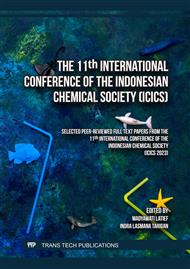[1]
Y.L.N. Murthy, B. Govindh, B.S. Diwakar, K. Nagalakshmi, S. Rajendra, A simple inexpensive detection method of nickel in water using optical sensor, Inter J. ChemTech Research, 3(2011), 1285-1291.
Google Scholar
[2]
X. Huang, Y.Hao, H.Wu, Q.Guo, L.Guo, J.Wang, L.Zhong, T.Lin, F.Fu, G. Chen, Chemical Magnetic Beads Based Colorimetric Detection of Mercuric Ion, Sens Actuators B. Chem, 191(2014) 600-604.
DOI: 10.1016/j.snb.2013.10.025
Google Scholar
[3]
A.Fahmi, W.B. Kurniawan, A.Indriawati, Potassium Thiocyanate (KSCN) Linearity Test as an Indicator, JRFI, 2(2022), 26-30.
Google Scholar
[4]
N.T. Muliawati, D.Siswanta dan N.H. Aprilita, Development of a Simple Fe(II) Ion Colorimetric Sensor from the Immobilization of 1,10-Phenanthroline In Alginate/Pectin Film, Indones. J. Chem, 21(2021), 411-420.
DOI: 10.22146/ijc.56759
Google Scholar
[5]
L.Chen, X.Tian, D.Xia, Y.Nie, L.Lu, C.Yang, Z.Zhou, (2019). Novel Colometric Method for Siumultaneous Detection and Identification of Multimetal Ions in Water : Sensitivity, Selectivity, and Recognition Mechanism, ACS Omeg, 4(2019), 5919-5922.
DOI: 10.1021/acsomega.9b00312
Google Scholar
[6]
R.K. Adhikamsetty, N.R. Gollapalli, S.B. Jonnalagadda, Complexation kinetics of Fe2+ with 1, 10‐phenanthroline forming ferroin in acidic solutions, International Journal of Chemical Kinetics, 40(2008), 515-523.
DOI: 10.1002/kin.20336
Google Scholar
[7]
J. Necas, L.Bartosikova, Carrageenan : A Review. Vet. Med., 4(2013), 187–205.
DOI: 10.17221/6758-vetmed
Google Scholar
[8]
A. Athipornchai, P. Pabunrueang, T. Trakulsujaritchok, Mangiferin loaded carrageenan/ chitosan core-shell hydrogel beads: Preparation, characterization and proposed application. Food Hydrocolloids, 147(2024), 109394.
DOI: 10.1016/j.foodhyd.2023.109394
Google Scholar
[9]
A. Lendlein, A.Sisson, Handbook of Biodegradable Polymers. Weinheim: Wiley-VCH, 2011.
Google Scholar
[10]
Riyanto, Validation and Verification of Test Methods in Accordance with ISO/IEC 17025 Testing and Calibration Laboratory, Yogyakarta, Deepublish, 2014.
Google Scholar
[11]
N.C.ASusanto, Mudasir, D.Siswanto, Fabrication and Optimization of Water Dissolved Metal Color Sensors with Carrageenan Matrix, JITK, 4(2020), 60-67.
Google Scholar
[12]
V.Spínola, E.J. Llorent-martínez, P.C. Castilho, Determination of Vitamin C in Foods: Current State of Method Validation, J. Chromatogr. A., 1369(2014), 2–17.
DOI: 10.1016/j.chroma.2014.09.087
Google Scholar
[13]
I.M. Yermak, V.I. Gorbach, I.A. Karnakov, V.N. Davydova, E.A. Pimenova, D.A. Chistyulin, V.P. Glazunov, Carrageenan gel beads for echinochrome inclusion: Influence of structural features of carrageenan, Carbohydrate Polymers, 272(2021), 118479.
DOI: 10.1016/j.carbpol.2021.118479
Google Scholar
[14]
F.S. Uy, A.J. Easteal, M.M. Fard, Seaweed Processing Using Industrial Single-Mode-Cavity Microwave Heating: A Preliminary Investigation, Carbohydr. Res., 340(2005), 1357-1364.
DOI: 10.1016/j.carres.2005.02.008
Google Scholar
[15]
C. Li, S. Hein, K.Wang, Chitosan−Carrageenan Polyelectrolyte Complex for the Delivery of Protein Drugs, ISRN Biomaterials, (2013), 1-6.
DOI: 10.5402/2013/629807
Google Scholar
[16]
D.A. Ondigo, Z.R. Tshentu, N. Torto, Electrospun Nanofiber Based Colorimetric Probe for Rapid Detection of Fe2+ in Water, Anal. Chim. Acta, 804(2013), 228–234.
DOI: 10.1016/j.aca.2013.09.051
Google Scholar
[17]
A. Rohman, I.G. Ganjar , Analytical Pharmaceutical Chemistry. Yogyakarta : Pustaka Pelajar, 2007.
Google Scholar
[18]
D.C. Harris, Quantitative Chemical Analysis, W.H. Freeman and Company, New York, USA, 2010.
Google Scholar


